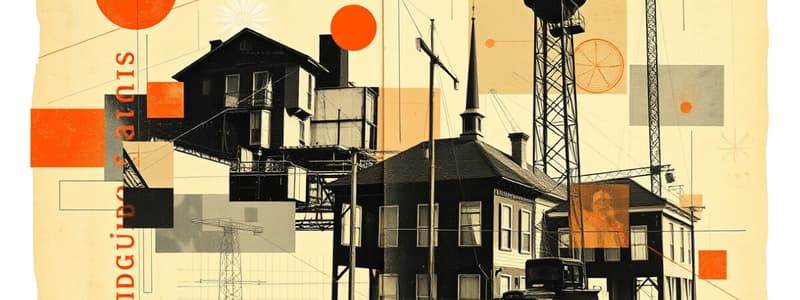Podcast
Questions and Answers
What is the main focus of the International Building Code (IBC)?
What is the main focus of the International Building Code (IBC)?
- Cost management
- Insurance services
- Fire prevention (correct)
- Material sourcing
What organization is mainly focused on data and risk management for insurance companies?
What organization is mainly focused on data and risk management for insurance companies?
- National Fire Protection Association (NFPA)
- International Building Code (IBC)
- Federal Emergency Management Agency (FEMA)
- Insurance Services Office (ISO) (correct)
All construction types must be classified into the following: Frame, Joisted Masonry, Light Noncombustible, Masonry Noncombustible, Modified Fire Resistive, and __.
All construction types must be classified into the following: Frame, Joisted Masonry, Light Noncombustible, Masonry Noncombustible, Modified Fire Resistive, and __.
Fire Resistive
What is the significance of the IBC to ISO conversion?
What is the significance of the IBC to ISO conversion?
What does 'Protected' mean in relation to building classification?
What does 'Protected' mean in relation to building classification?
What are the two major factors for building classification?
What are the two major factors for building classification?
What does the fire-resistance rating indicate?
What does the fire-resistance rating indicate?
A wood roof is always the weakest element in a masonry building.
A wood roof is always the weakest element in a masonry building.
What elements must be known to determine the ISO Class of a building?
What elements must be known to determine the ISO Class of a building?
Frame buildings generally have roof, floor, and supports of combustible material, usually made of _____ .
Frame buildings generally have roof, floor, and supports of combustible material, usually made of _____ .
What is one condition that could lead to classification as frame construction?
What is one condition that could lead to classification as frame construction?
Flashcards are hidden until you start studying
Study Notes
International Building Code (IBC)
- Primarily utilized by architects and builders in the USA.
- A model building code developed for standardizing construction practices.
- Emphasizes fire prevention across various structures.
Insurance Services Office (ISO)
- Provides essential services including data, underwriting, risk management, and legal assistance for insurance firms.
- Uses a 6-tier classification model for determining construction types.
- Conversion knowledge between IBC and ISO is crucial for accurate structure classification.
Basic Model Breakdown
- Construction types are categorized into six types:
- Frame
- Joisted Masonry
- Light Noncombustible
- Masonry Noncombustible
- Modified Fire Resistive
- Fire Resistive
IBC to ISO Conversion Table
- IBC and ISO are key sources for construction type classifications; IBC is used by architects while ISO is standard for insurance.
- Misclassification risk exists if IBC designs are improperly submitted as ISO types.
- Protected classification indicates structures with fire-rated coatings offering at least 1-hour fire resistance.
- Unprotected classification means structural members without added fire resistance.
- Sprinkled denotes full installation of fire sprinkler systems; unsprinkled signifies absence of such protection.
Building Classification
- Determined by two main factors:
- Building elements
- Fire resistance capabilities
Building Elements
- Key components include:
- Structural frame
- Exterior and interior bearing walls
- Nonbearing walls and partitions
- Floor and roof constructions, along with supporting beams and joists
Fire-Resistance Rating
- Represents the time span a passive fire protection system can endure in a standard fire test.
- Ratings can vary from 0 hours to 2 hours, indicating the structure’s fire endurance.
Minimum Rule
- Construction strength correlates directly with the weakest structural element.
- Example: A masonry building with a weak, unprotected wood roof is classified as Joisted Masonry; a metal deck roof raises the classification to Masonry Noncombustible.
What to Ask?
- Key questions to establish ISO class should address details about:
- Structural frame
- Bearing wall specifications (interior and exterior)
- Floor construction
- Roof construction
- Fire ratings of materials used
Frame (ISO Class I, IBC Type V)
- Defined as buildings with combustible external walls, floors, and roofs.
- Typically features wood or other combustible materials in construction.
Frame Continued
- Masonry veneer and metal-clad exteriors do not alter the frame classification:
- Masonry veneer serves aesthetic rather than structural purposes.
- Metal-clad may suggest sturdiness but is classified as frame if supported by combustible materials.
- Additional factors can lead to frame classification, such as:
- Metal walls or floors with combustible sheathing
- Combustible insulation attached to metal roofs or floors.
Studying That Suits You
Use AI to generate personalized quizzes and flashcards to suit your learning preferences.




